This Week in Anime
Middle Earth, Circa 1978
by Lucas DeRuyter & Steve Jones,
Before the new The Lord of the Rings: The War of the Rohirrim anime film comes out, Steve and Lucas take a trip back to 1978 to talk about the original animated version.
Disclaimer: The views and opinions expressed by the participants in this chatlog are not the views of Anime News Network.
Spoiler Warning for discussion of the series ahead.
The Lord of the Rings animated film is currently streaming on HBO Max.
 @RiderStrike
@RiderStrike
|
 @BWProwl
@BWProwl
|
 @LucasDeRuyter
@LucasDeRuyter
|
 @vestenet
@vestenet
|
Steve
Lucas, we have an unusual TWIA in store today, so I'd like to begin with an unusual proposal. No matter what point we try to make or what joke we try to construct, I'd like us to post nothing but copies of the below image. That way, Lynzee will have no choice but to use it as this article's thumbnail, and we can help put Hobbits' feet where they belong: on ANN's homepage.

Lucas, we have an unusual TWIA in store today, so I'd like to begin with an unusual proposal. No matter what point we try to make or what joke we try to construct, I'd like us to post nothing but copies of the below image. That way, Lynzee will have no choice but to use it as this article's thumbnail, and we can help put Hobbits' feet where they belong: on ANN's homepage.
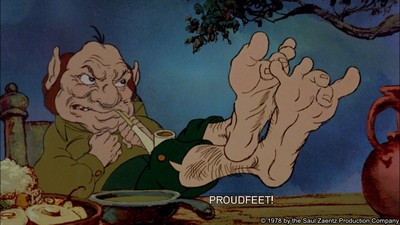
Lucas
Steve, people can say what they will about the 1978 The Lord of the Rings animated movie (and we're about to say plenty more!), but there's no denying that this movie is absolutely CINEMA for folks into freaky lil' hobbit feet.

Look at those hairy, chonky grippers! If you're into folks who are twinks up top and bears from the ankle down, I cannot recommend the 1978 The Lord of the Rings movie enough!
Steve, people can say what they will about the 1978 The Lord of the Rings animated movie (and we're about to say plenty more!), but there's no denying that this movie is absolutely CINEMA for folks into freaky lil' hobbit feet.
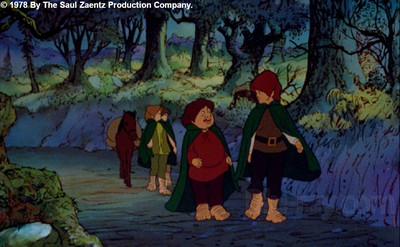
Look at those hairy, chonky grippers! If you're into folks who are twinks up top and bears from the ankle down, I cannot recommend the 1978 The Lord of the Rings movie enough!
True, I suppose the average still from this film has a sufficiently high probability of fuzzy feet to render my proposal unnecessary. Fair enough. And speaking of being fair, yes, this animated feature directed by Ralph Bakshi, produced in America, and partially filmed in Spain in no way qualifies as anime. You caught us. But there is an anime The Lord of the Rings feature fast approaching, and because it's difficult/frowned upon to constantly pause and hit "print screen" while you're in the multiplex, we've landed on covering this adaptation as a compromise. Don't like it? Too bad.

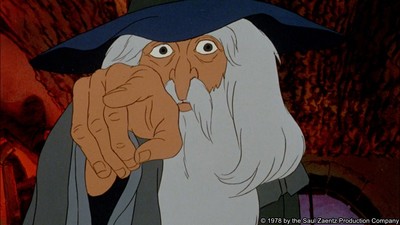
Honestly? I liked it more than I thought I would! Sure, the performances are amateurish to middling, the movie only covers two-thirds of The Lord of the Rings story, and there are far too many lingering shots of characters emoting nonsensically, but this film goes hard in some ways I wasn't expecting and deeply respect.

I'm well aware that Tolkien's proclivity for attributing a character's morality to their race is deeply problematic and is responsible for a lot of racist tropes in fantasy fiction, but the way this movie depicts orcs is metal as hell. These are some of the evilest dues I've ever seen on screen!
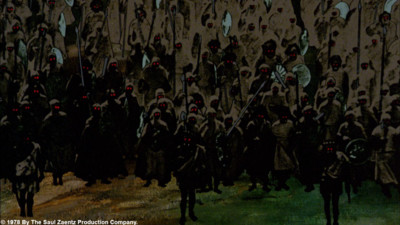
I'm well aware that Tolkien's proclivity for attributing a character's morality to their race is deeply problematic and is responsible for a lot of racist tropes in fantasy fiction, but the way this movie depicts orcs is metal as hell. These are some of the evilest dues I've ever seen on screen!
This was my first brush with this adaptation, but not with LOTR in general. Peter Jackson's films are foundational for me, hitting right in that sweet spot of the transition between middle and high school, and they prompted me to read Tolkien's novels around the same time. I didn't turn into one of those Middle Earth obsessives who pored over the pages of The Silmarillion, but The Lord of the Rings is a story I'm very familiar with and have great affection for. So, I was also surprised by how much I enjoyed this version despite its flaws.

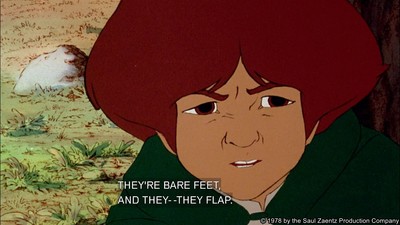
I can appreciate the movies, but they were less than foundational for me. Though, I have a deep intellectual curiosity in Tolkien's body of work, and I even took a class my freshman year of college that was essentially a comparative reading of Seamus Heaney's translation of Beowulf and Tolkien's The Hobbit.

That being said, I'm confident in saying that the 1978 film, with its distorted live-action segments, rotoscoping, and more experimental feel overall, is likely to be a more authored and possibly thought-provoking work than the upcoming The Lord of the Rings: The War of the Rohirrim anime film.
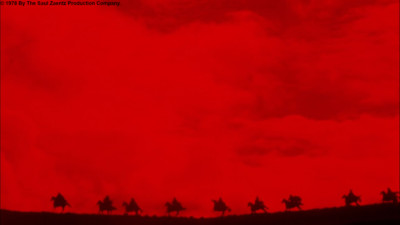
That being said, I'm confident in saying that the 1978 film, with its distorted live-action segments, rotoscoping, and more experimental feel overall, is likely to be a more authored and possibly thought-provoking work than the upcoming The Lord of the Rings: The War of the Rohirrim anime film.
I mean, I think most animators would have a difficult time living up to Bakshi's oeuvre and reputation, checkered though it may be. Through his work in the '70s, he's often credited for expanding America's animation audience and appetite outside of the family-friendly Disney fair that had dominated the industry up to that point. You could even argue he helped pave the way for the gritty, cerebral anime films and OVAs that found some popularity in the American market in the '80s and '90s.
Incidentally, if you want more background on Ralph Bakshi and this film in particular, Dan Olson has a great hour-long video digging into this stuff.
I can totally believe that! I had known for a while that Tolkien's work had an incredible impact on the heavy metal music genre, but I wasn't aware of the history of that influence. Seeing the fantastical, almost alien, backgrounds of the 1978 film helped me click into place how these styles of art became in conversation with each other. (Also, ya know, most people making metal/hardcore/industrial music are big ol' dorks in the best way possible.)

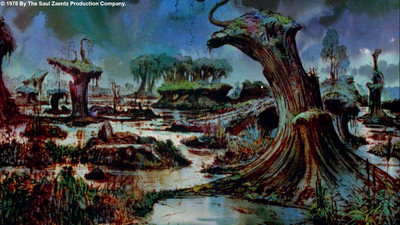
It's a movie that deserves to be seen painted on the side of a van. Like, at its best, it's incredibly evocative, if not avant-garde.




Its legacy can also be felt in Jackson's adaptation. As I understand it, the lineage is complicated and not wholly intentional. Still, Bakshi's framing here of the Ringwraith searching for the Hobbits is basically one-to-one with how the live-action version depicts it, down to how the lads are hiding in the nook of that tree.


People were calling LoTR unfilmable at the time, so it's to Bakshi's credit that he turned it into something at least partially iconic.
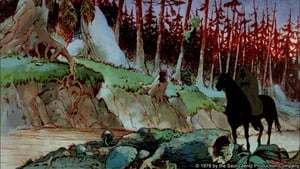
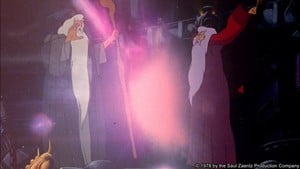
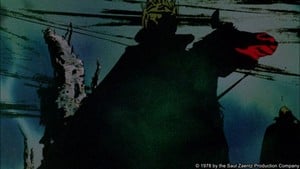
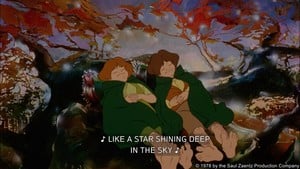
Its legacy can also be felt in Jackson's adaptation. As I understand it, the lineage is complicated and not wholly intentional. Still, Bakshi's framing here of the Ringwraith searching for the Hobbits is basically one-to-one with how the live-action version depicts it, down to how the lads are hiding in the nook of that tree.
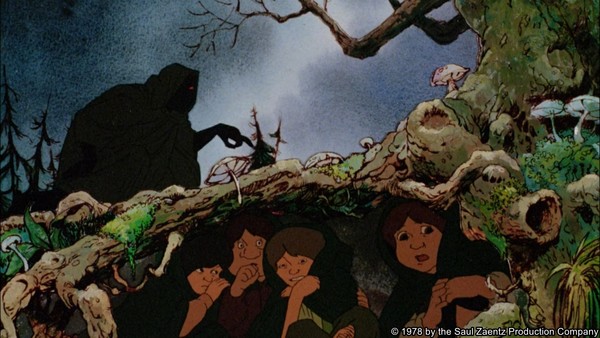
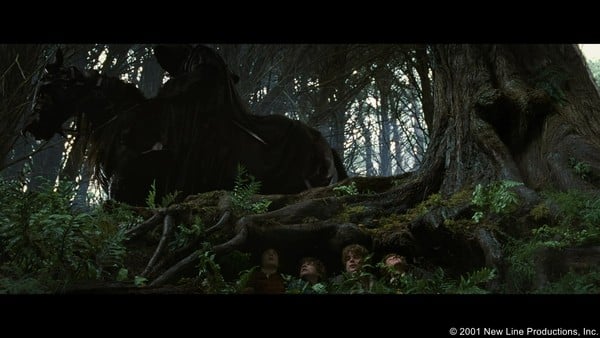
People were calling LoTR unfilmable at the time, so it's to Bakshi's credit that he turned it into something at least partially iconic.
Absolutely, the 1978 film was clearly a massive undertaking by people who cared deeply about the source material, and for that, Bakshi and team have my respect.

Though, this is maybe where my praise for the film begins to run out. While I love the direction the movie went in, it's a pretty significant departure from the "timeless epic" tone that Tolkien was overtly going for with LotR. Take the 1978 movie's take on the Balrog, for example. This flaming chimera looks more like a mini-boss from a 1990s adventure game than Satan made manifest on Earth.
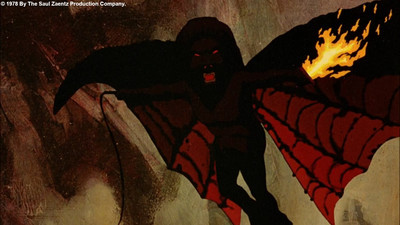
Though, this is maybe where my praise for the film begins to run out. While I love the direction the movie went in, it's a pretty significant departure from the "timeless epic" tone that Tolkien was overtly going for with LotR. Take the 1978 movie's take on the Balrog, for example. This flaming chimera looks more like a mini-boss from a 1990s adventure game than Satan made manifest on Earth.
He's so goofy, and I kinda love him, but you're correct. While Jackson's films mostly work as a cohesive whole that sweeps you into the story, the 1978 cartoon has a lot of these moments and creative decisions and compromises that pull you out of it. They're not all bad, though. I think the opening narration, for instance, is charmingly cheesy. It doesn't even attempt the pretense of looking animated, as it's all shadowplay done by real actors behind a red filter/screen. I can't say I've seen something like that in another major animated motion picture, so I appreciate the novelty.

The film itself, too, is a constantly shifting blend of styles and techniques that bleed into each other in a lot of fascinating (and not always great) ways.

The film itself, too, is a constantly shifting blend of styles and techniques that bleed into each other in a lot of fascinating (and not always great) ways.
Dude, the opening to this movie whips, and I think this red background and silhouette is an inspired way to convey that the lore behind this story is happening centuries, if not millennia, ago. As though time has shifted not only the world but reality itself.

The rotoscoping, when not used to make orcs look demonic, is less effective and tactfully used. This shot of two humans, one rotoscoped and one more traditionally animated, looks more like something out of an episode of Smiling Friends than an epic fantasy story.
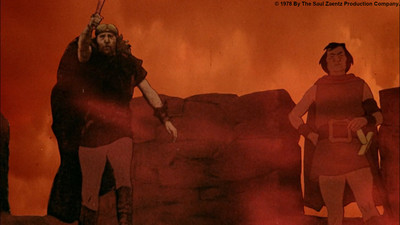
The rotoscoping, when not used to make orcs look demonic, is less effective and tactfully used. This shot of two humans, one rotoscoped and one more traditionally animated, looks more like something out of an episode of Smiling Friends than an epic fantasy story.
So, there are a few different techniques going on here. As we all know from Hiroshi Nagahama's hit adaptation of The Flowers of Evil, rotoscoping is animating by drawing and painting over live-action footage. There's a lot of that in this film, and it works really well, conveying stuff like subtle body language, the weight of clothing, momentum, and so on.

There's also partial rotoscoping, where animators draw over a portion of the live-action footage. So the orcs, for instance, get beady red eyes and big silly white teeth. That's how you know they're orcs.

And then there's also a lot of live-action footage that's processed in a particular way, but otherwise not animated at all. Like this guy in Bree. I love this guy and his mustache. But he's not a cartoon. You get this effect by exposing and xeroxing the film in a particular way.

And you do all this because, as it turns out, drawing an entire 2+ hour epic fantasy cartoon is really, really hard and expensive and time-consuming.
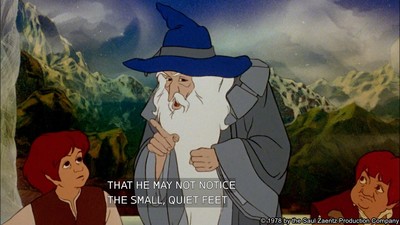
There's also partial rotoscoping, where animators draw over a portion of the live-action footage. So the orcs, for instance, get beady red eyes and big silly white teeth. That's how you know they're orcs.
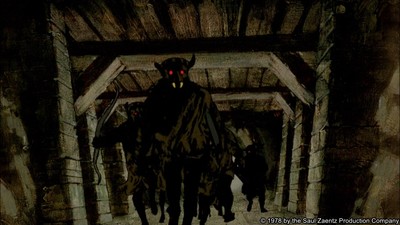
And then there's also a lot of live-action footage that's processed in a particular way, but otherwise not animated at all. Like this guy in Bree. I love this guy and his mustache. But he's not a cartoon. You get this effect by exposing and xeroxing the film in a particular way.
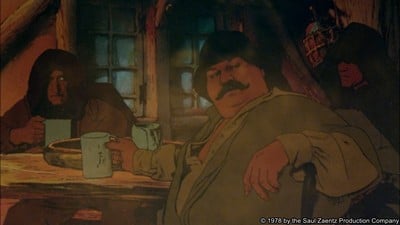
And you do all this because, as it turns out, drawing an entire 2+ hour epic fantasy cartoon is really, really hard and expensive and time-consuming.
There's an argument to be made that, as Middle Earth is a melting pot of creatures from different divine and demonic origins, this hodgepodge of different visual styles is more appropriate than Jackson's cinematic direction in his LotR films.

But things also look unintentionally off just often enough that I'm not sure how much of this uncanniness is deliberate and how much is a sometimes happy accident.
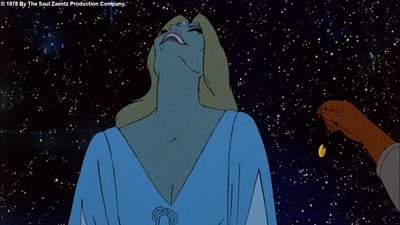
But things also look unintentionally off just often enough that I'm not sure how much of this uncanniness is deliberate and how much is a sometimes happy accident.
I generally don't mind the awkwardness of it all because it's very singular and unique. There are plenty of more traditionally and cohesively animated films out there. I like watching one that gets weird with it. But you can't ignore how these disparate elements often work against each other. It's wild to see the same characters in the same scene flip back and forth between their rotoscoped versions and their heavily filtered live-action stand-ins.


The battle scenes are the "worst" offenders since their complexity necessitates extensive live-action components, so you get scenes that mix these techniques and make the contrast even more jarring.

The modern anime way of dealing with large crowds, by the way, is 3D modeling, which they didn't have in 1978. Is that better or worse than live-action footage? I'm not here to say, but I just think it helps to look at these components as solutions to a problem using the technology they had at the time.
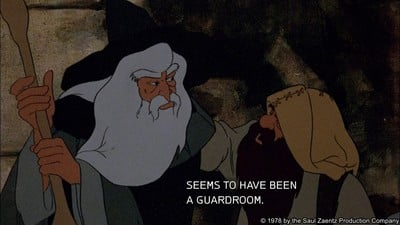

The battle scenes are the "worst" offenders since their complexity necessitates extensive live-action components, so you get scenes that mix these techniques and make the contrast even more jarring.
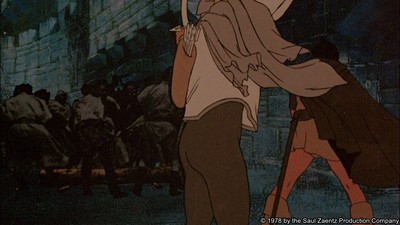
The modern anime way of dealing with large crowds, by the way, is 3D modeling, which they didn't have in 1978. Is that better or worse than live-action footage? I'm not here to say, but I just think it helps to look at these components as solutions to a problem using the technology they had at the time.
Oh, I completely agree that the history of the animation medium and the technology fueling it need to be remembered when watching this film. After all, a big part of why Jackson's films are still celebrated to this day is because of how they use new special effects technologies to capture the scale of The Lord of the Rings books, which was previously thought to be impossible.

I guess I'm just frustrated that the Bakshi movie keeps switching between using more novel visual techniques in a way that feels diegetic and a way that feels convenient. Like, semi-transparent live-action footage used to depict camouflaged and insanely evil spook-a-dooks? Brilliant! 10/10! Super inspired and affecting! Using a similar technique to make an unrelated sequence of movements easier to depict on film? Eh, I get it, but that's less cool to me.
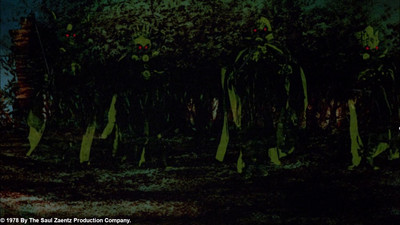
I guess I'm just frustrated that the Bakshi movie keeps switching between using more novel visual techniques in a way that feels diegetic and a way that feels convenient. Like, semi-transparent live-action footage used to depict camouflaged and insanely evil spook-a-dooks? Brilliant! 10/10! Super inspired and affecting! Using a similar technique to make an unrelated sequence of movements easier to depict on film? Eh, I get it, but that's less cool to me.
It's frustrating, and the film's structural issues exacerbate it. Pacing is all over the place; it makes some jarring cuts to the story, and most problematically, it tries (and fails) to cram both The Fellowship of the Ring and The Two Towers into a single movie that lacks a proper ending.

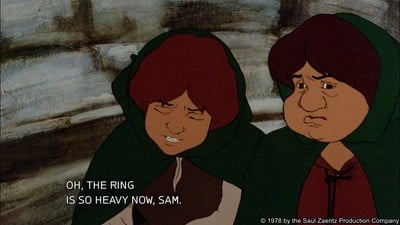
It's frustrating, but it's also darkly hilarious that the ending to this fantasy epic is, "Gandalf chases off some orcs" and "Sam and Frodo walk into the (miasma obscured) sunset with their new best buddy Gollum." The ending is so bizarre and abrupt that I can't even imagine what the team's original plan for wrapping this up was.

Also, if this version of Gollum got his own video game, I'm convinced it would be a GOTY content. Look at this monster man! Who wouldn't wanna run around as him in a video game!?
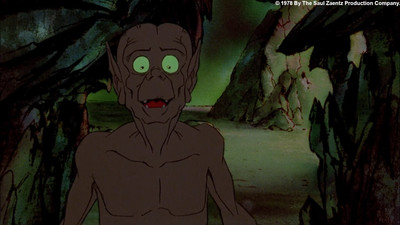
Also, if this version of Gollum got his own video game, I'm convinced it would be a GOTY content. Look at this monster man! Who wouldn't wanna run around as him in a video game!?
Me. No, thank you. Anyway, Bakshi originally wanted to do a proper trilogy, was negotiated down to two movies, and then never made the sequel for a variety of reasons (probably because making this one was already so difficult). And contemporary audiences, expecting the full story, were pretty pissed at the time too. There's a funny-in-hindsight anecdote on the movie's Wikipedia page: United Artists refused to put a "Part 1" in the film's title because they didn't believe audiences would pay to see half a movie. Oh, if they only knew.
Considering, at this point, Bakshi was already pretty foundational in advancing both the medium of animation and adult animation as a genre, I can't blame him for not wanting to hitch himself further to The Lord of the Rings wagon. Fingers crossed that The War of the Rohirrim is a bit more narratively complete than its animated forefather.
I am interested in seeing so for myself, but as Rohirrim is its own story, I will have to approach it differently than this one. My favorite thing about this adaptation was experiencing a tale I was already familiar with through a fresh, creative vision. Knowing the novels helped fill in the movie's many gaps, and knowing Jackson's version helped elucidate a lot of the cool stuff here. For example, the scene at Galadriel's scrying pool has a completely different tone in Bakshi's version. She teases Frodo with a whimsical irony, swishing her robes around as if she had already fully realized the foolishness and futility of taking the Ring for herself.




It's a far cry from Jackson's and Blanchett's horror-tinged vision of an apocalyptic maybe, and I like that! I think both reads of the material work, making me appreciate the source even more.


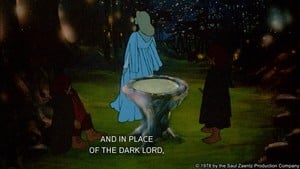
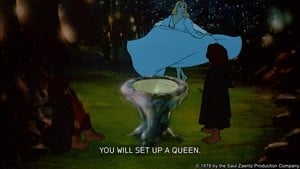
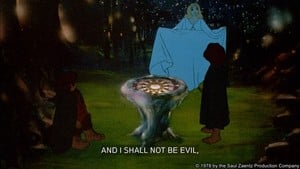
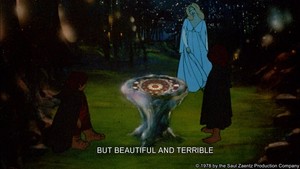
It's a far cry from Jackson's and Blanchett's horror-tinged vision of an apocalyptic maybe, and I like that! I think both reads of the material work, making me appreciate the source even more.
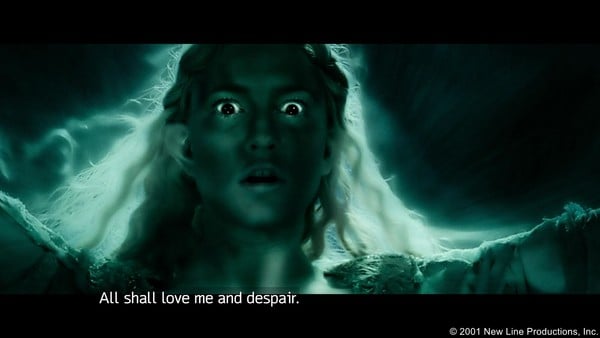
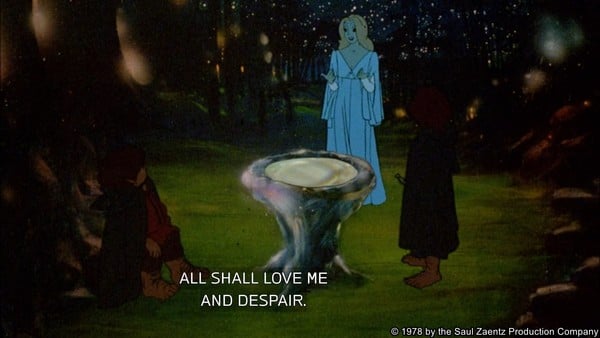
If nothing else, this iteration of The Lord of the Rings further proves that Tolkien created a culturally defining epic with his original work. A work being reinterpreted, reimagined, and recontextualized over time is the biggest indication that a story has captured an intrinsic part of the human experience, and that's why we keep getting new versions of other timeless stories like Journey to the West or the aforementioned Beowulf.
Admittedly, it's going to be difficult for any of the inevitable future The Lord of the Rings adaptations to have a better Legolas than this. Just look at him. He's perfect, and he's voiced by Anthony Daniels. This is my canonical Legolas now. Sorry, Orlando.

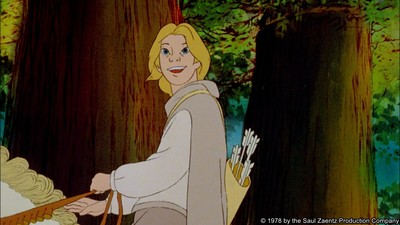
Similarly, I'm now forever going to head-canon Frodo as having the most intense bratty bottom energy imaginable! Elijah Wood's performance has a tinge of this, but he doesn't hold a subby candle to his animated counterpart.


Jackson's films win overall on homoeroticism, though. Like, Frodo and Sam have a lot of cute interactions here, but the live-action version fully understands that they're boyfriends and deeply in love.


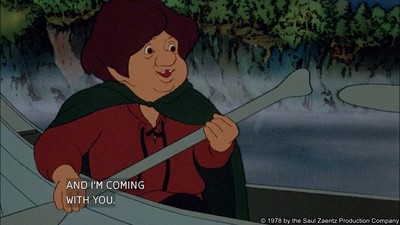
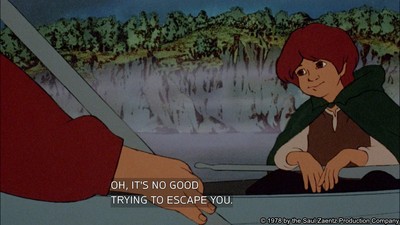
As I'm sure Tolkien intended with his generations-spanning Jesus allegory, that was mostly just an excuse for him to come up with a bunch of fictional languages and lore to justify them.
As sure as Boromir's beard is luscious.

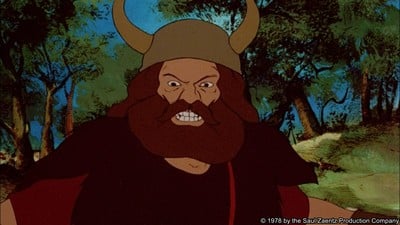
discuss this in the forum (22 posts) |